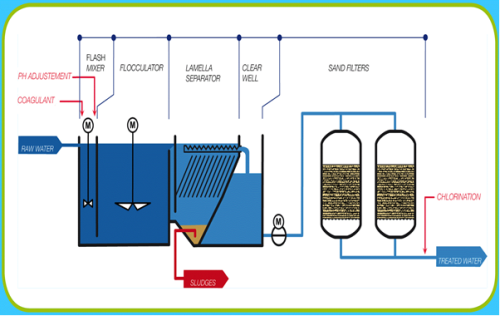
Optimization of conventional treatment of the surface water treatment plant of the city of Khenifra
Abstract
Treatment of the surface water of the city of Khenifra combines a conventional treatment and a membrane process unit (reverse osmosis). The conventional treatment in question uses an aluminium base reagentin the form of Aluminum sulphate that may cause leaks of Aluminum called "residual Aluminum" in the filtered water. The objective of this work is to study the elimination of residual aluminum, resulting from the conventional treatment, for a better operation of the demineralization unit by Reverse Osmosis, located downstream. Indeed, according to the requirements of the supplier of the membranes, the residual aluminum content should not exceed 0.05mg/L. The jar test remains the most used test, at the level of the laboratories, which allows optimizing the doses of treatment reagents to be used in a treatment plant; particularly the aluminum sulfate coagulant. Trials of the jar test were performed and had been optimized by the application of Doehlert experimental design.
The effectiveness of the treatment and the optimum conditions through the stages of treatment are achieved by monitoring the parameters: pH, turbidity and residual aluminum.
Full Text:
PDFReferences
- A. Lachheb, S. Belhamidi, N. Zouhri, Y. A. Idrissi, M. Hafsi, M. Taky, M. El Amrani1 and A. Elmidaoui, Performances analysis of the reverse osmosis desalination plant of brackish water used for drinking water: Tagounite, Morocco, Journal of Chemical and Pharmaceutical Research, 2016,119-129.
- M. Farhaoui, M. Derraz, Review on Optimization of Drinking Water Treatment Process, Journal of Water Resource and Protection, 2016, 777-786.
- T. H. Karim, B. Brahim, B.A. Mansri, Comparative Study Between New Polyacrylamide Based Copolymer Poly(AM-4VP) and a Cationic Commercial Flocculant: Application in Turbidity Removal on Semi-Industrial Pilot, Journal of Polymers and the Environment, 2018, 1550-1558.
- B. Meghzili, Z. Marsa, M.S. Medjram, Catal. Sci. Technol, 2008, 71-78
- R. Babu, N.S. Badri Narayana, N.S. Begum, N. Anantharaman, J. Chem. Technol. Metall, 2007, 201-206.
- A. Mukheled, Int. J. Water Res. Environ. Eng, 2012, 4, 79-92.
- E. Lefebvre, Wat.Sci.Tech, 1990, 591-606.
- P.K. Raghuwanshi, M. Mandloi, A.J. Sharma, H.S. Malviya, S. Chaudhari, Int J Environ Res Public Health.2, 2014, 47-58.
- N. E L Harrak, F. Elazhar, S. Belhamidi, M. Elazhar, J. Touir, A. Elmidaoui, Journal of Materials and Environmental Science, 2015, 383-390.
- M. Hafsi, A. Khaoua, S. Ben Abdellah, M. E1 Mghari, Desalination, 2004,167, 209-216.
- E. O. Oke, L.A. Jimoda, D.O. Araromi, Determination of biocoagulant dosage for water clarification using developed neuro-fuzzy network integrated with a user-interface-based calculator, Water Science and Technology: Water Supply, 2017,18, 1783-1792.
- B. Lamrini, E.K. Lakhal, A Survey of Deep Learning Methods for WTP Control and Monitoring, Desalination and Water Treatment, 2018.
- J. GOUPY, Plans d’expériences pour surfaces de réponse Ed. Dunod (1999)
- E.P. George, B. Norman, R. Draper, Empirical model-building and response surface, Ed. John Wiley &Sons, 1987.
- D.H. Doehlert, Uniform shell designs, 1970, 231-9.
- C.T. Driscollm, W.D. Schecher, A.M.A. Arch. Ind. Health, 1988, 59-122.
- M. Farhaoui, M. Derraz, J. Chem. Pharm. Res, 2016, 749-775.
DOI: http://dx.doi.org/10.13171/mjc7619011409mea
Refbacks
- There are currently no refbacks.
Copyright (c) 2019 Mediterranean Journal of Chemistry
